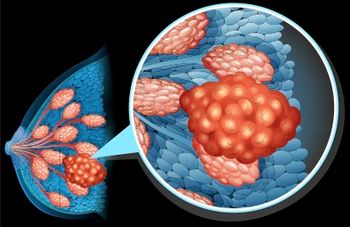
Gemcitabine Fails in Early Breast Cancer
Final 10-year follow-up of a large phase III trial showed that adding gemcitabine to anthracycline and taxane-based adjuvant chemotherapy increases toxicity and does not improve disease-free survival in early breast cancer patients.
Final 10-year follow-up of a large phase III trial showed that adding gemcitabine to anthracycline and taxane-based adjuvant chemotherapy does not improve disease-free survival (DFS) in early breast cancer patients, similar to what earlier analyses from the trial found. The addition of gemcitabine also increased toxicity, confirming it should not be added to standard chemotherapy for these patients.
Based on preclinical evidence suggesting a favorable interaction between paclitaxel and gemcitabine, as well as other clinical research, “it seemed plausible that addition of gemcitabine to paclitaxel in the anthracycline plus cyclophosphamide regimen might further improve DFS and overall survival in early-stage disease,” wrote study authors led by Helena M. Earl, MBBS, of Addenbrooke’s Hospital in Cambridge, United Kingdom. The TANGO trial was designed to test that hypothesis.
A total of 3,152 patients were enrolled between August 2001 and November 2004; they were randomized 1:1 to receive epirubicin, cyclophosphamide, and paclitaxel either with or without gemcitabine. Results of the final study analysis were
After a median follow-up of 10 years, 914 patients had died and there were 1,087 DFS events. DFS at 10 years was 65% in both of the two groups, and the median DFS was not reached. An adjusted analysis showed a hazard ratio (HR) for DFS of 0.97 (95% CI, 0.86–1.10; P = .64). This was similar to results seen at 2 years and at 5 years.
Overall survival was also no different between the groups, with an HR of 1.02 (95% CI, 0.89–1.16; P = .81). Subgroup analyses showed similar results with and without gemcitabine across groups stratified by age, hormone receptor status, and other factors.
Though both regimens were reasonably well tolerated, certain grade 3 adverse events (AEs) were more common with gemcitabine; these included neutropenia, myalgia and arthralgia, fatigue, infection, and others. A total of 83 gemcitabine patients (5%) and 45 control group patients (3%) discontinued chemotherapy because of drug-related toxicity. Serious AEs were also more common with gemcitabine.
“Gemcitabine in combination with paclitaxel after epirubicin and cyclophosphamide is therefore not indicated in adjuvant breast cancer treatment with current biological characterization,” the authors concluded. “However, further improvements in treatment outcomes for women with early breast cancer are likely to depend on the development of targeted therapies whose selective application is predicated on the biological heterogeneity of this disease.”
Newsletter
Stay up to date on recent advances in the multidisciplinary approach to cancer.


















































































